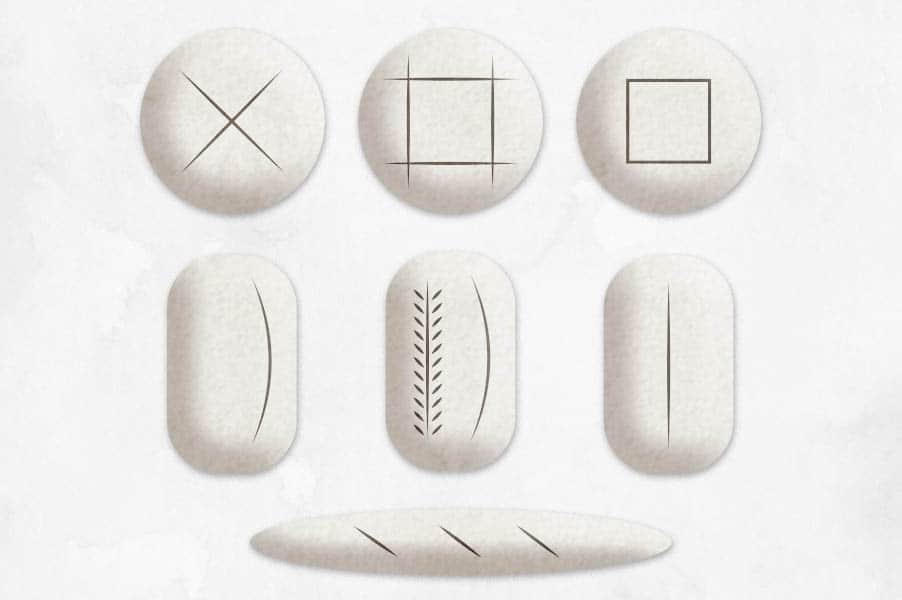If you’ve looked up scoring techniques, you’ve probably come across some really beautiful designs. We are regularly blown away by what some people are able to do. They are truly artists!
However, that can cause some of us to think scoring is all about presentation. Don’t get me wrong, presentation is a major reason why bakers do it. However, it isn’t the whole story.
Bread dough is scored to encourage expansion during baking. Since the outer layer of dough develops a crust and hardens before it finishes rising, it is beneficial to provide a weak spot (or spots) for it to expand. It is almost like telling dough where you want it to expand. However, scoring is not necessary, but if done well, it will produce bread with a larger rise and one that is more even.
If you’ve ever seen pictures of bread with huge “blowouts” that is typically due to bread that hardened too quickly but found the natural weak spot in the dough’s gluten development. With a hard crust, the only place to expand was out of the weak spot.
Dough that has really strong gluten, and isn’t scored can actually come out pretty flat if the crust formed early. This has to do with such a strong crust, that there was nowhere for the dough to escape. This results in a really dense and gooey loaf of bread.
How To Score Dough?
Scoring dough is as simple or complicated as one wants to make it, kind of like all things in the bread world. But for best results, especially starting out, keeping it simple is ideal. It will give you an idea of what is actually happening as you score before taking on some of those more complicated patterns.
The first thing you’ll need is a sharp knife, or even better a razor blade or lame (it rhymes with mom). It’s French for blade, and has come to represent the standard bread scoring tool. Though, Wire Monkey scoring tools are becoming very popular. Scissors also work in a pinch, especially for some patterns on round loaves. The simple cross is perfect with scissors.
Cold stiff dough is far easier to score than warm soft dough. If your dough is really wet, it can be pretty challenging. Bakers often coat the top of their dough with rice flour for contrast after baking (stays white even after baking), but what isn’t always pointed out is that it actually makes scoring a bit easier as it helps the blade along the top of the dough.
Quick single motions are best, but if you work slower you’ll get by just fine. Like everything, this takes practice. Give some of these simple/common scoring patterns a try.

What About Bread That Isn’t Scored?
Bread varieties that aren’t scored, often include ingredients like oil, dairy, and dough softeners. These do not need scoring as they bake up without a crispy crust like artisan bread loaves. Think sandwich loaves, bagels, rolls and more. The added fat or conditioners help keep the bread soft and pliable all throughout the baking process.
But you’ve probably seen those really beautiful rustic loaves that are cracked all over and have great rise without scoring. Those are totally possible with a variety of techniques. Let’s address the two primary routes to get there.
- Seam-Side-Up Baking
When baking upside down, or seam up, you have a natural weak spot where the seam is located. This encourages the dough to rise up through that area. We’ve seen some really beautiful results this way. Just be prepared for some random and gnarly looking loaves from time to time. But we don’t mind that at all! We like to eat bread more than we like to look at it.But those times when a perfect beauty comes out, we get to do both.
- High Moisture
When you are baking in a Dutch oven, or have a method for creating an ample amount of steam in your oven this can produce beautiful natural cracked bread. We like spraying the top of our dough with a spray bottle before tucking it into our Dutch oven when going this route. Helps keep things moist and encourage some cracking.
Take care to make sure your dough is strong and your shaping was done evenly. With a weak gluten structure, we find a blowout happens from time to time this way. But you know what, blowouts happen from time to time when you’re learning, even when you score your dough. It still tastes good and that helps with the learning process. Failed loaves are often still delicious!
Either way you go, just try to anticipate what the end loaf is going to look like. Then compare how they turned out. After a dozen loaves or so, you’ll really start to get a feel for what is happening with your loaves during your bakes.

